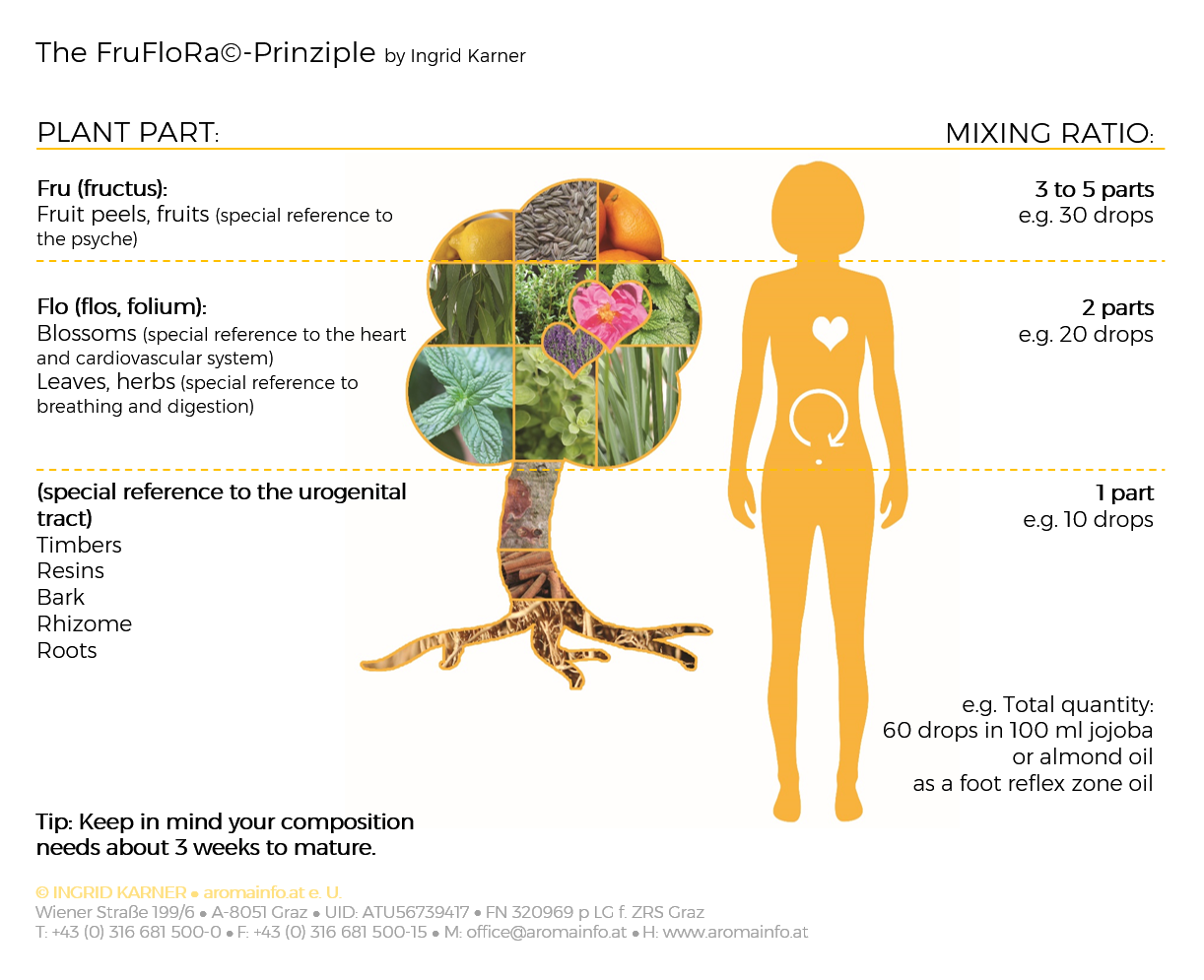Scentnews
FruFloRa©-Principle
After almost 20 years of practical experience and more than 10,000 fragrance compositions, Ingrid Karner has developed the FruFloRa © principle. It is used to create pleasantly fragrant and holistic effective fragrance compositions made from 100% pure natural essential oils and extracts. The creation of mixtures according to head-heart-footnotes has been further developed: the FruFloRa © principle is based on the dosage guidelines for head-heart-foot mixtures, but the allocation of the oils is different than in the literature.
How exactly does it work?
The allocation of the pure natural essential oils and extracts to head (“Fru”), heart (“Flo”) and base notes (“Ra”) is based on the “FruFloRa© principle” exclusively according to the part of the plant from which the fragrance is obtained. Experience has shown that these mixtures have a more holistic effect than the use of components from just one or two fragrance levels (e.g. only citrus and flower oils).

Exceptions
Patchouli…
is obtained from the leaves but has a very intense earthy scent. This essential oil should only be used in small amounts and never as the sole Flo-Note.
Needle oils from silver fir, silver fir, spruce, pine and Douglas fir …
are extracted from the “leaves” (needles) and twigs (wood). Here, the dosage takes place either as a heart OR as a base note – depending on the fragrance preference.
Joker: Vanille…
Vanilla is obtained from the fruit (pod), but can be used as a Fru, Flo or Ra note – depending on the fragrance preference.
“Relaxation mixture” according to FruFloRa© principle
Vanille as Fru-Note
3 drops vanilla extract
2 drops lavender
1 drops sandalwood
in 10ml of almond oil
Vanille as Ra-Note
3 drops mandarin red
2 drops lavender
1 drops vanilla extract
in 10ml of almond oil
“Relaxation mixture” according to FruFloRa© principle
White fir as Flo-Note
3 drops juniper berry
2 drops white fir
1 drops benzoin
in 10ml of almond oil
White fir as Ra-Note
3 drops lemon
2 drops Myrtle ct. Myrtle acetate
1 drops white fir
in 10ml of almond oil
Chakra assignment
Furthermore, a very simple assignment to the chakras (energy centers) can be made this way:
- Head notes (“Fru”) from fruits & seeds: crown and frontal chakra
- Heart notes (“Flo”) from leaves: throat chakra
- Heart notes (“Flo”) from flowers: heart and solar plexus chakra
- Base notes (“Ra”) from woods, resins and roots: sex chakra, root chakra
TIP:
The assignments to head-heart-footnotes according to the FruFloRa© principle do NOT correspond to the assignment information in the literature. It is a different assignment principle. Please do not be confused: when you mix according to the FruFloRa© principle, only the plant part from which the fragrance is derived is relevant for the dosage. The effect of FruFloRa© blends is usually stronger than that of “normal” blends. The mixtures act holistically, so also on the energy system of the person.

How to proceed when mixing*
Blends of a maximum of three to five naturally pure essential oils have proven to be most effective. The essential oils complement each other through different ingredients and form “synergies”. Lavender oil in particular is said to enhance the effect in mixtures.
1.Label both vials and caps. Because nothing is more annoying than screwing the closure for clove oil onto a vial of rose oil.
2. What do I want to achieve with the mixture? (e.g. relax)
Start by clarifying what result you want to achieve and then select the appropriate oils from each fragrance level.
3.What kind of application is possible? (e.g. reflex zone oil)
4. Which basic substances are suitable? (e.g. almond oil, hydrolates)
After all possible fatty oils, vegetable fats or hydrolates have been listed, one decides for 1 to 3 of them.
5.Which essential plant oils do I use? (e.g. mandarin, lavender, vetiver).
Of the essential plant oils under consideration, decide on about 3-6 different ones.
- Do not mix oils with opposite effects in the beginning
- “Package” “healing” but rejected scents into “nice” scents
- Start with little or test the mixture on a scent-free paper strip that you fan in front of your nose. Increasing the dosage is always possible.
- Finally, you can use a drop of an oil with a very opposite or enhancing scent to round out or contrast the overall look of your blend.
6. Determination of the total quantity
7. Calculating the dosage of the basic substances
8. Calculate the dosage of the essential oils
9. Write down the mixing ratio (recipe) so that you can recreate the successful mixture at a later time. This will also help you know later what may have caused skin irritation or allergy.
10. Filling: Use clean empty mixing containers (vials).
11. For applications on the skin, do a compatibility test on the inside of the forearm beforehand. Wait a few hours. Do it especially if you are not sure whether the person will tolerate the mixture or if it is a very sensitive person (child, very old person, allergy sufferers, etc.).
*The information on how to create a composition is provided for private use only. The commercial use of the composition e.g. for educational purposes is not allowed. However, we release the FruFloRa© principle for commercial purposes under the indication of the source (“© Ingrid Karner – aromainfo.at”).
Bildquelle: Chakra/Frau: Photo by Natalie Grainger on Unsplash